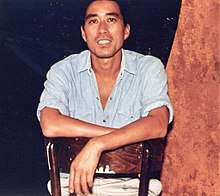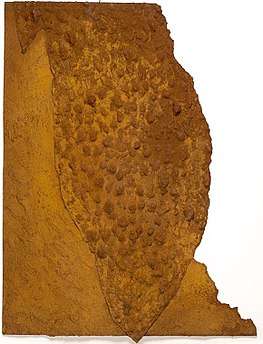Ching Ho Cheng
Ching Ho Cheng (December 26, 1946 – May 25, 1989) was a contemporary artist who lived and painted in New York City during the 1970s and 1980s. His work consists of four distinct periods: Psychedelics, Gouache, Torn Works and the Alchemical Series, all primarily executed on paper. As an artist who was well versed in world literature, it is evident that his body of work has been influenced by Egyptian mythology as well as his following of Taoism, which embodied his beliefs in the universal renewal of life.
Ching Ho Cheng | |
|---|---|
 | |
| Born | December 26, 1946 |
| Died | May 25, 1989 (aged 42) |
| Nationality | United States of America |
| Alma mater | Cooper Union for the Advancement of Science and Art |
| Relatives | Paifong Robert Cheng (father) Rosita Yu-fan Cheng (mother) Sybao Cheng-Wilson (sister) Tcheng Yu-hsiu (great aunt) |
| Awards | Pollock-Krasner Foundation Grant 1985, Artists Space/Committee of Visual Artist Grant 1984 |
| Website | chinghocheng |
Life and work
An American of Chinese descent, Ching Ho Cheng was born in Havana, Cuba, in 1946.[1] Cheng was the son of Chiang Kai-shek's last ambassador to Cuba. During the mid-1960s he studied painting at the Cooper Union School of Art in New York City, and during the early seventies lived in Paris and Amsterdam, where, in 1976, he had his first one-man show. Cheng returned to New York that same year and checked into the Chelsea Hotel intending to remain for two months; he lived and worked there until his death in May 1989.

Ching Ho Cheng created artwork from torn paper. To create these variously scaled abstract pieces, Cheng applied iron powder to torn paper which was sealed with waterproof layers of gesso, mat medium and modelling paste employed to create a sense of relief. He used a special catalyst to begin a lengthy chemical process of transforming the iron into rust. The paper was soaked in water for days and dried, acquiring a hard surface. Cheng controlled the process by deciding when to remove the paper from the bath. Cheng would sometimes resoak the paper in order to obtain the desired surface and textural coloration. He manipulated viscous surfaces with the smaller works and hoped to achieve a greater impasto with the larger torn paper pieces, as these pieces had a tendency to break if too heavily laden.[2]
At a time when Asian-Americans were nearly absent from the contemporary art scene, Cheng was highly regarded by peers and by prominent art historians such as Gert Schiff and Henry Geldzahler, the first curator of twentieth-century art at the Metropolitan Museum of Art. Notable collectors of his work are Miles Davis, Louise Fletcher, Aldo Cipullo, Princess Caroline of Monaco, Alfonso Ossorio, Peggy Cooper Cafritz, Countess Claude de Lesse and others. Cheng exhibited his work extensively in New York and overseas.
Archives
Ching Ho Cheng's personal letters, photos, drawings and artifacts are housed at the Smithsonian Archives of American Art in Washington, DC.
Selected collections
- Whitney Museum of American Art
- Hirshhorn Museum and Sculpture Garden
- Cleveland Museum of Art
- The Phillips Collection
- Brooklyn Museum
- Montclair Art Museum
- Detroit Institute of Arts
- Minneapolis Institute of Art
- Grey Art Gallery
- Everson Museum of Art
References
- Stavitsky, Gail (September 1988), "Ching Ho Cheng", Art in America
- Geldzahler, Henry (November/December 1988) "Studio Visit: Ching Ho Cheng", CONTEMPORANEA